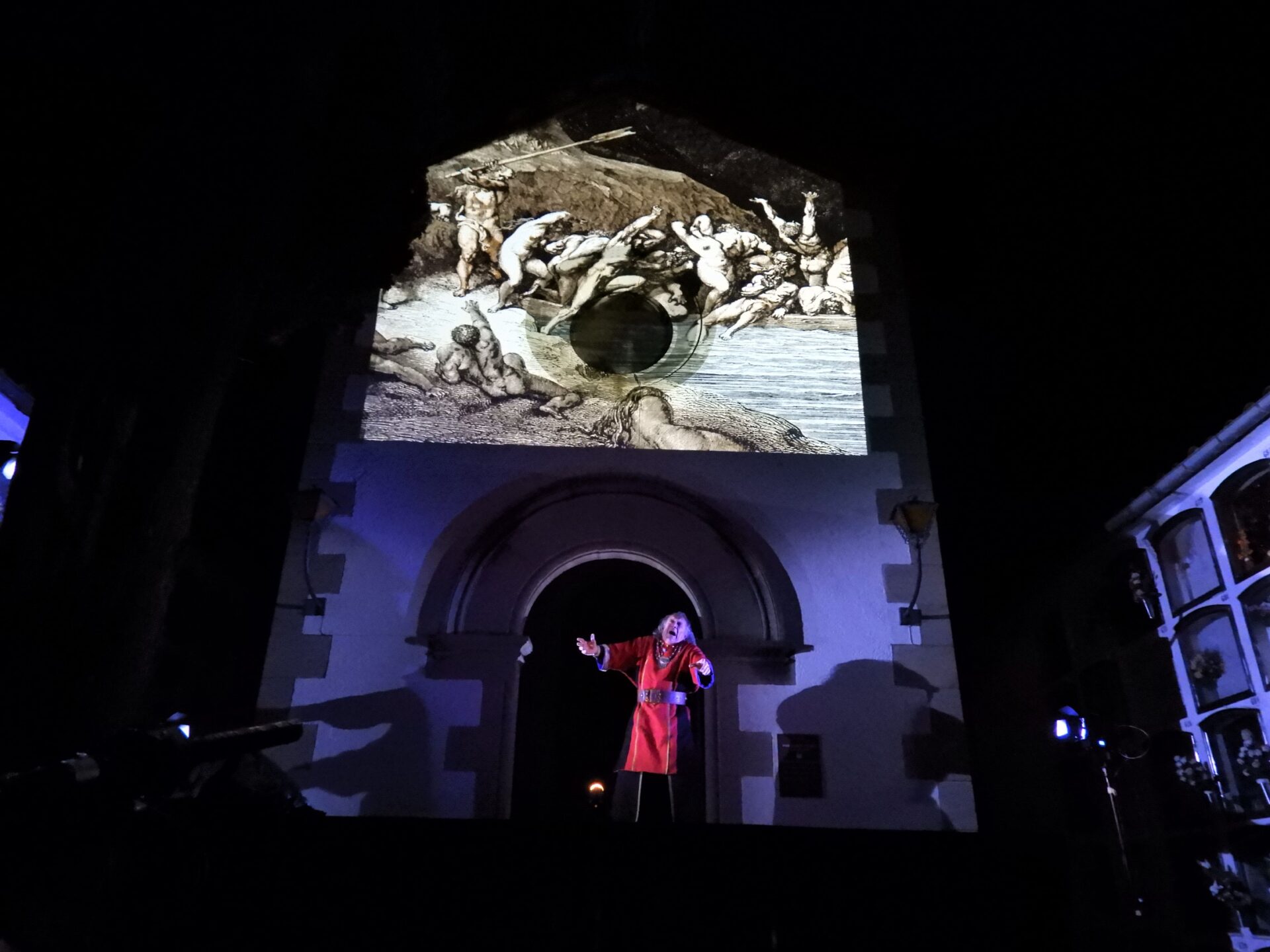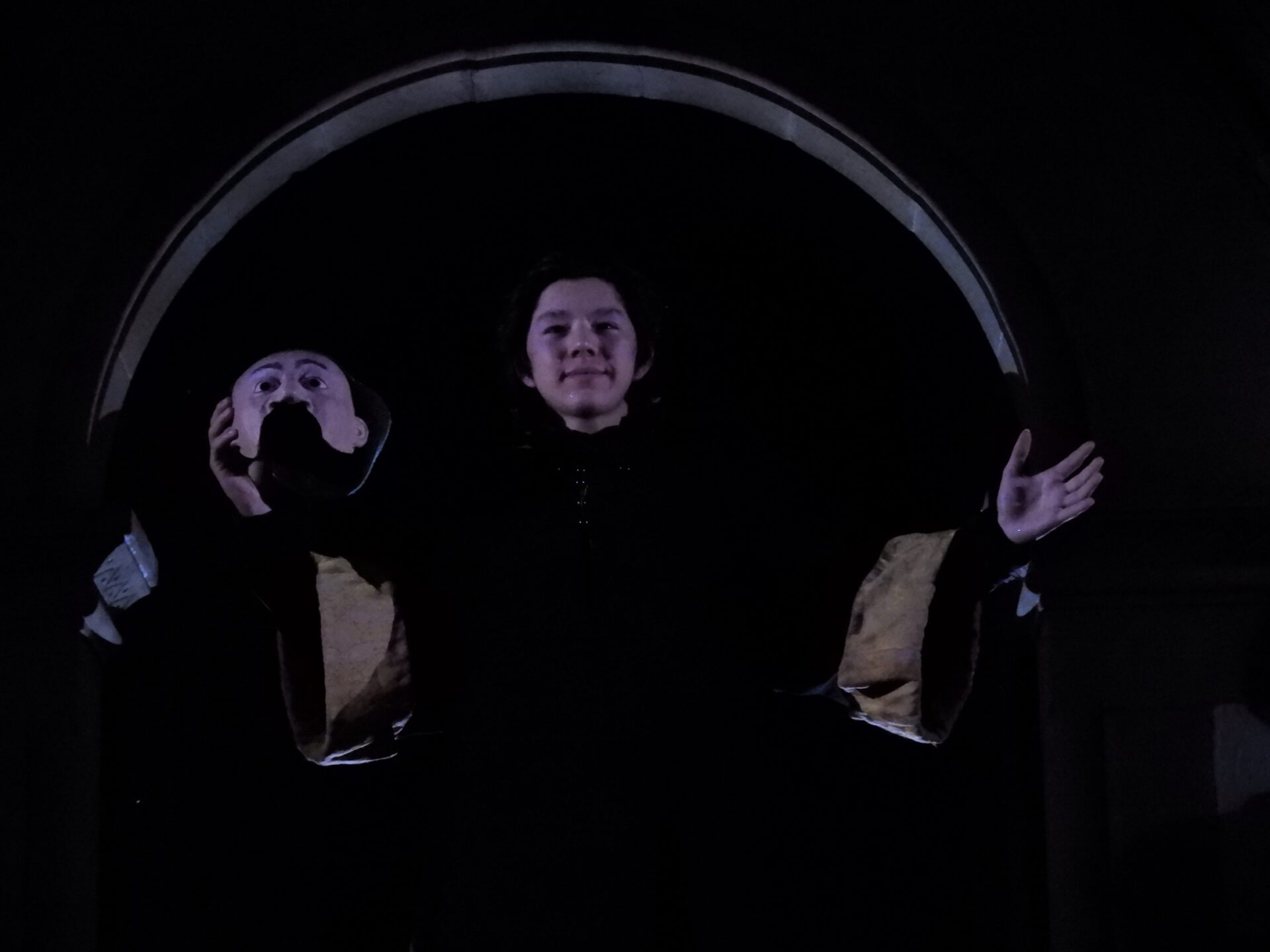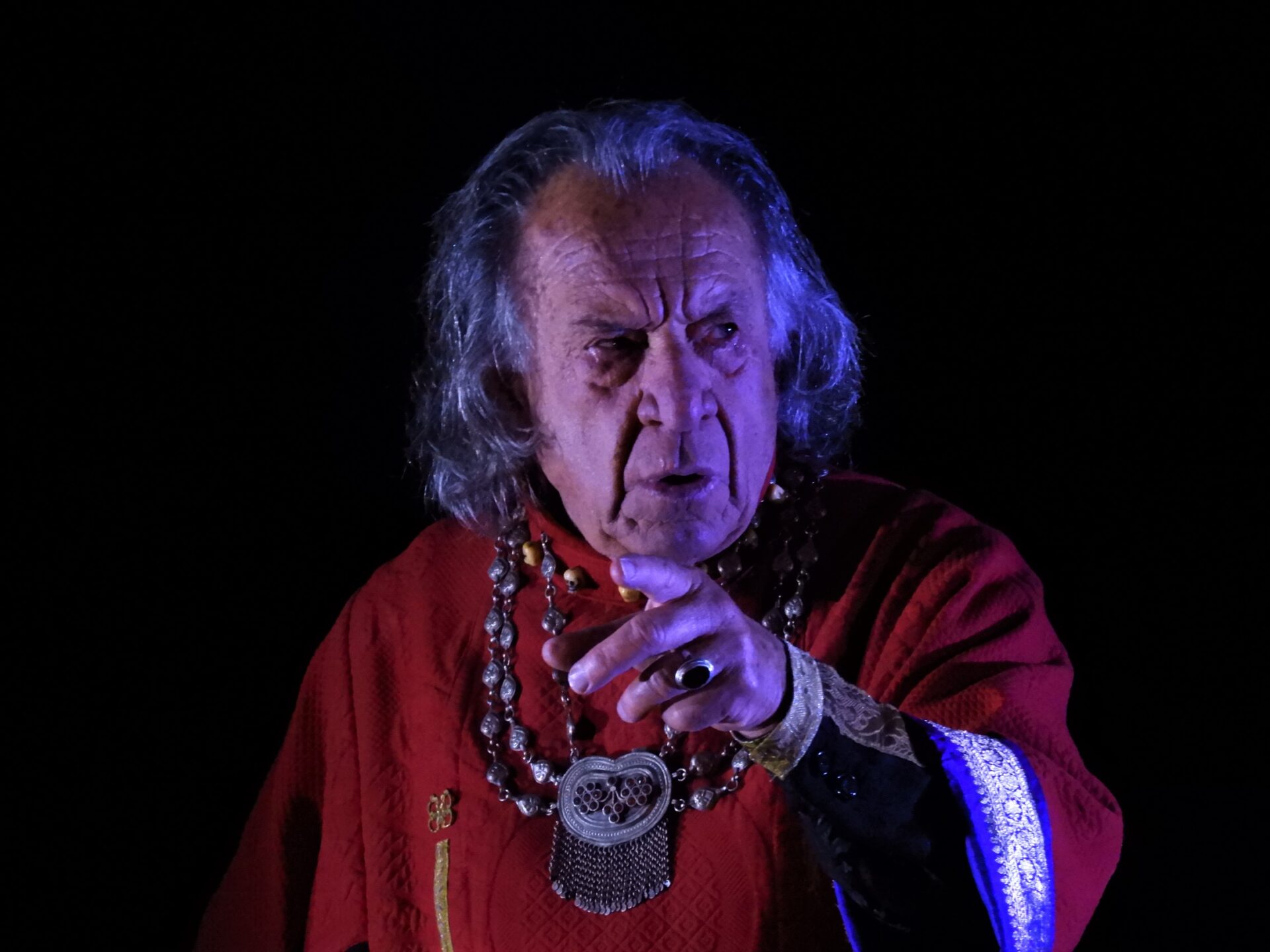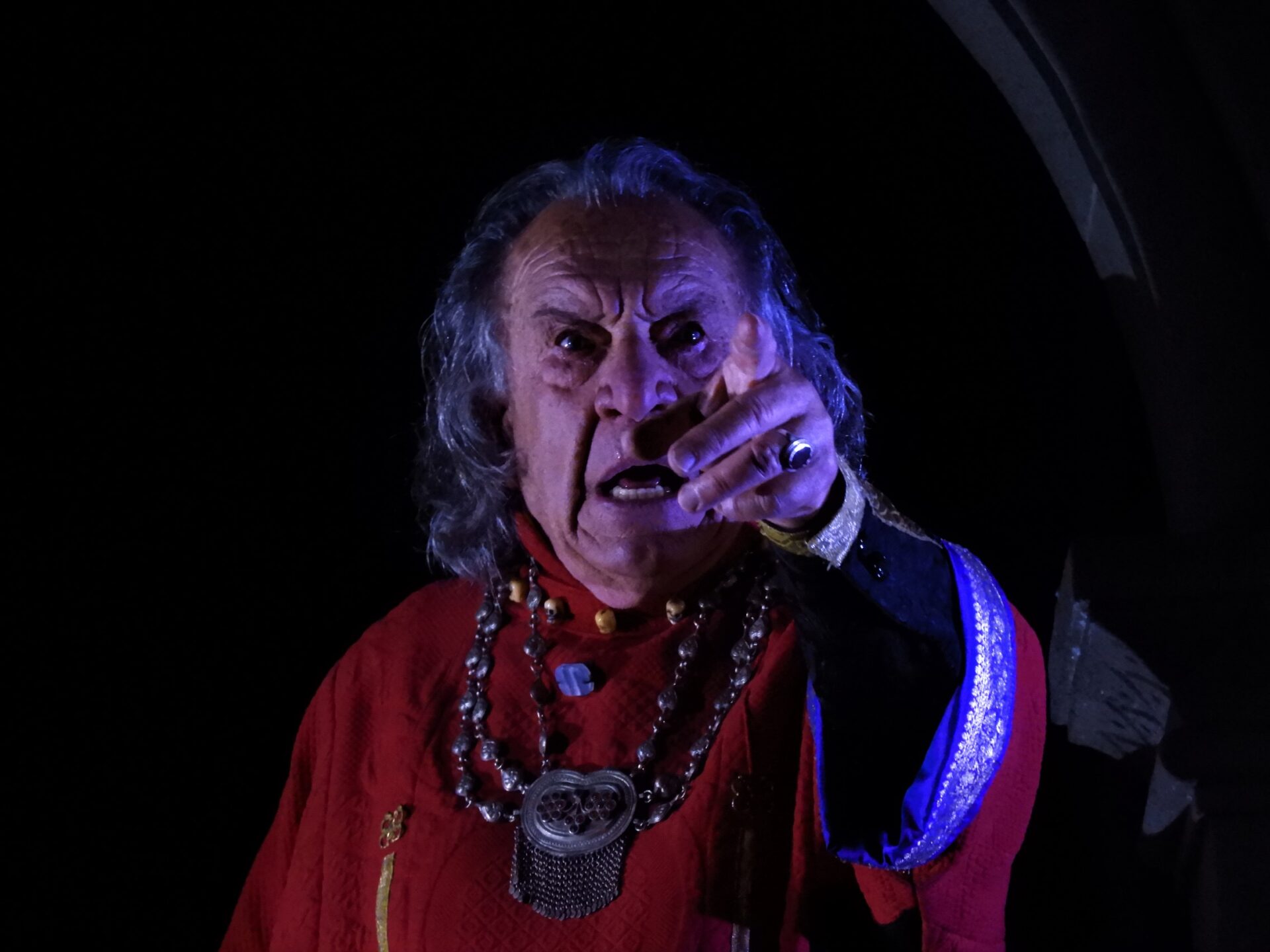| Year | 2021 |
| Category | Performance |
| Work | INFERNO |
| Premiere | Torelló. Municipal cemetery |
DANTE, GUIDED BY THE POET VIRGILIO, TRAVERSES THE INFERNOS
INHABITED BY THE SHADOWS OF SINNERS
Albert Vidal recounts the journey accompanied by illustrative images of Dante’s itinerary. Earthly chants accompany the passionate recitation of the abysses of the underworld.
Canto III. We will discover in the circle of the indifferent those who, out of cowardice or negligence, did not undertake any commitment in their lives. We will see the demon Caronte ferry them across the river with strokes of an oar to transport them to the other side in a journey of no return.
Canto V. We will witness the fervent love of Paolo and Francesca, enraptured in their adultery, murdered by Paolo‘s jealous brother.
Canto VI. Circle of the Gluttonous where the incontinent gluttons will suffer the bites and tearing of the demon Cerbero, the rabid three-headed dog.
On their way, they meet Ciacco, a famous character from Dante‘s time, who was mocked by everyone for his irrepressible gluttony. This one will continue sunk in the infected mud until the final judgment.
These three acts are recited by the rhapsody in the original language, that is, in Tuscan of the 1300s, to give more authenticity to the horrors and sufferings of those who delivered their souls to the king of evil.
At the end of the three songs, Albert Vidal will address the public; this time, with some verses by Agostino Manni (1600 AD) translated into local language about the importance of ethics and good behavior in order to be worthy of existing in this world.
ARTISTIC DATA SHEET
Rhapsode Albert Vidal
Dante’s shadow Noè Vidal
Viola de arco Xavier Macaya
Violin Ricard Vallina
Costumes Oghi Ochir
Sound space Denys Sanz
Light design and mappings Jordi Pérez
REVIEW
“THROUGH ME YOU GO INTO ETERNAL PAIN”
O
DANTE IN PERSON
The invitation stated INFERNO – Cirvianum Teatre Torelló, date: 29/05/2021 at 10 p.m. It didn’t mention anything about the local cemetery, but I knew it was going to be there, and the truth is, I harbored a certain suspicion about the event, fearing to appear as a character in a theatrical anecdote. The cemetery of Torelló imposed silence and respect. Perhaps a bit of fear, enough that those of us who saw Albert Vidal reciting Dante’s Inferno at night in a cemetery unconsciously avoided dispersing too much. It was better to stay closer to each other.
Everything was unusual. I don’t know how to behave in cemeteries at night, so the strangeness completely overwhelmed me. But it didn’t last long. It began to fade from the moment I saw Albert Vidal’s hands, which with their unmistakable movements, began to emerge from a young body that was not his own. It was his son Noè who burst onto the stage, improvised at the entrance of the chapel, like an apparition.

Its great impact was achieved by the synchrony between the crashing sound and the exact moment of turning on the lights. Perhaps I took a step back at that moment. The surprising character, yes, that’s it, as if he had come from the shadows, his face covered with a mask, announced the journey through the inferno of the rhapsode, evoking Dante devastated by the death of his beloved and ready for all risks. “¡Beatrice! ¡Beatrice!”. The same gestures of mime and the earthy prince that Vidal has immortalized, were recognizable following the impulses of the other body on stage in a kind of generational relief. The gestures endure. Only the master changes
Illuminated by the lights, the numbers embedded in the niches where the ancient inhabitants of Torelló are buried were distinguishable. How to encapsulate lives? How to apprehend absences? How to give them shape? Some of the niches displayed flowers that moved with the gusts of wind and were increasingly watered by the raindrops. “Inopportune” – that’s what I thought at first, but as the spectacle progressed, I realized that the rain had a mobilizing effect and ended up catalyzing an even more intense creative discharge by Vidal. The artist had to confront it like the beast of Hell. And he mastered it, domesticated it, appropriated it From a certain moment in the performance, perhaps it was he who decided when the rain would stop or fall even harder. And it obeyed him.
The rhapsodist had summoned his inner spirit, undaunted to become a Dante Alighieri, relying on the assistance of his master Virgilio while he questioned him, listened to him, and allowed himself to be guided by him on the journey through hell. Reciting the 400 verses of the first cantos in tuscan, Vidal approached the gate of hell, crossed the vestibule of the cowards who have no hope of death, and recounted the torment of the souls transported by Caronte to the other side of the river in a journey without return. Then he passed through the circle of lust and gluttony, where for a moment he lent his body to Cerbero – the fierce three-headed dog. It seemed that Vidal was going to become him definitively. We saw his jaws! But no. Some moments later he returned to his role as a rhapsodist narrating the events like a painter painting, like a musician activating notes, like a magician capable of exhaling perfumes. All gathered there heard lamentations, growls, saw the tumult of tormented souls, felt the texture of the mud. And before us, we barely had the body of Albert Vidal…
In fact, the person we truly had before us was Dante Alighieri. Vidal was Vidal no more. “Dimmi, maestro mio, dimmi, segnore”. It was Dante in person. The artist wasn’t revitalizing tradition or updating it. He went to inhabit it. And he let Dante inhabit his body, celebrating a festive, sacred time that embraces Chaplin, Jacques Lecoq, Kazuo Ohno, Darío Fo. The great masters have never left. They are still here. They are Albert Vidal. Perhaps they will be his son Noé. Their legacy lies in those who have not yet surrendered in our performance-driven society, in those who have preserved their connection to the sublime and their desires intact, unregulated by anyone, as a reason to be. They are few, truthfully, but enough to know where we have gone wrong and to point out a new path in a creative act of salvation Just as Albert Vidal did reciting the chants of Dante’s Inferno.
It was a spring night in a graveyard when that creative act occurred, a vital act for us as a society, carried out by a Vidal that carries in his surname the word “life. Can one give life? A new life? Perhaps that act was the beginning of a new way of thinking, a new way of acting, a new era in which we can reclaim the connection with knowledge and ethics. It will not be by chance that the artist bid farewell to the audience quoting the words of Agostino Manni (Italian writer of the seventeenth century) about the need for good deeds. Will we act rightly? Will we? What place will we want to occupy within the pantheon of characters representing human nature?
Jolanta Rękawek
Professor at the State University of Feira de Santana Bahia, Brazil. 15-06-2021
ALBERT VIDAL UPDATES DANTE’S “INFERNO”
AT THE TORELLÓ CEMETERY
THE ARTIST ONCE AGAIN PIONEERS WITH HIS MORE ORIENTAL MYSTIQUE
Albert Vidal, the most internationally renowned Catalan performer, once again proved to be a pioneer and unique in his latest artistic creation. Within the framework of the Festus Festival, the chosen stage was the Torelló cemetery, a place as unusual as the artist himself, where last weekend he twice represented in rhapsodic format the verses of Dante’s Inferno from The Divine Comedy. This was a work in ancient Tuscan, delivered from memory and with impeccable, respectful, careful, austere, sensitive, delicate, approachable staging, open to a multitude of emotional and personal reflections from all attendees.
Vidal surpassed himself once again, and not even the rain on Saturday for over half an hour could stop him. With the strength of his words and characteristic gestures, he presented a very personal work, conceived over the last three years in his production space in Vidrà.
This piece had already premiered at the end of 2019 on the -2 floor of the parking lot of the Atlántida theater, but now it has been updated and adapted to an unusual space where this type of performance is not usually carried out.



Albert Vidal continues to present transgressive, unique, and less conventional proposals, as is the case with the Torelló cemetery. He is capable of reciting from memory 400 hendecasyllabic verses as if he were a troubadour from the 14th century. These verses represent the odyssey of the protagonist to the heart of darkness and abyss, accompanied by the poet Virgilio.
To complete this careful work, the presence of Albert Vidal’s legacy in his son, Noè, was not lacking. At just sixteen years old, he promises to be the continuator of his father’s wisdom, gesturality, and singularity, a direct disciple of the best masters such as Jacques Lecoq, Dario Fo, and Kazuo Ohno.
Albert Vidal, who has traveled all over the world, has drawn inspiration from diverse sources such as the Topeng dance techniques in Bali, Butoh in Japan, and Borí possession in Niger. In addition, in his long professional career, he has recorded the first telluric chants in India, in the north of the Iberian Peninsula, and in Mongolia.
Toni Carrasco. Osona.com. 01-06-2021
